AI in Art Statistics 2024

Since the groundbreaking release of ChatGPT in late 2022, there has been an increasing focus on the generative AI tool’s growing ability to replicate creative pursuits traditionally carried out by humans.
While initially the focus was centered around generative AI’s ability to perform text-based tasks like article writing, poetry, and story creation, the rise of text-to-image platforms like Midjourney has seen more people than ever using the technology to produce visual art in the style of drawings, paintings, and photographs.
But what does the future hold for the use of AI in art? To shed more light on this increasingly relevant topic, AIPRM collated this AI art statistics page covering market size, facts about AI in art, and more.
Top 10 AI art statistics #
- The global AI image market is projected to be worth over $0.9 billion by 2030, a 254% increase from 2022 ($0.26 billion).
- In 2030, at least one blockbuster film is expected to be released, with 90% of the content generated by AI.
- Nearly half of artists (45.7%) found text-to-image technology very useful in their artistic process, with just under a third (31.5%) finding it somewhat useful.
- Around one in ten (11.2%) artists had used text-to-image technology to create something resembling a fully digital work.
- Less than one in ten (8.2%) artists said they planned to showcase their text-to-image generated work in art venues.
- More than half (53.6%) of artists felt that they made a fundamental input to the artwork created while using text-to-image technology.
- Midjourney is the most popular AI generator for creating images, holding more than a quarter of the market (26.8%).
- Dall-E 2 was the most popular text-to-image tool among artists, with more than a quarter (28.3%) citing it as their preferred tool.
- Nearly a third of text-to-image AI users considered the technology to be a major advancement for visual arts.
- 70% of US adults think that artists should be compensated when generative AI uses their work to produce images.
AI in art market statistics #
The latest AI art statistics predict that the global AI image market could be worth over $0.9 billion by 2030. If projections are correct, it will mean the industry will more than triple in value (+254%) from 2022, when it was worth just under $0.26 billion.
A breakdown of the value of the global AI image market in 2022 and the projected values for 2023 and 2030 #

* Figures from 2023 onwards are market projections
The projected industry value for 2023 stood at just under $0.3 billion ($0.29 billion), representing a rise of just under 12% from 2022. Should 2030 projections prove right, the AI art market size will grow by around 217% between 2023 and 2030.
How long has AI art been around? #
While AI art may feel like a new phenomenon, its origins can be traced back to decades before the recent generative AI boom. Artist Harold Cohen began exploring the concept of using AI to create art in the early 1970s, resulting in the emergence of his groundbreaking Aaron program in 1973.
The primary function of Aaron was to teach a robot to create drawings, with Cohen honing and refining the program over 50 years to increase its accuracy and scope. While Aaron could only produce monochrome line drawings that were hand-coloured by Cohen in its early years, he later refined the program so that it could apply the colors independently. This resulted in the production of digital prints which are the complete work of Aaron.

The development continued over the next few decades, with Aaron able to produce increasingly abstract and sophisticated works by the 2000s. As a result, Cohen became an inspiration to many of the contemporary AI artists of the 21st century.
AI in art usage statistics #
AI art stats from Gartner predicted that by 2030, at least one major blockbuster film will be released, with 90% of the film generated by AI (from text to video). With these groundbreaking developments on the horizon, Platform.io surveyed over 500 artists in various fields to get their views on text-to-image technology.
Nearly half (45.7%) claimed they found it very useful in their artistic process, with just under a third (31.5%) claiming it was somewhat useful but did not integrate into their workflow.
A breakdown of the opinions of text-to-image technology from surveyed artists #
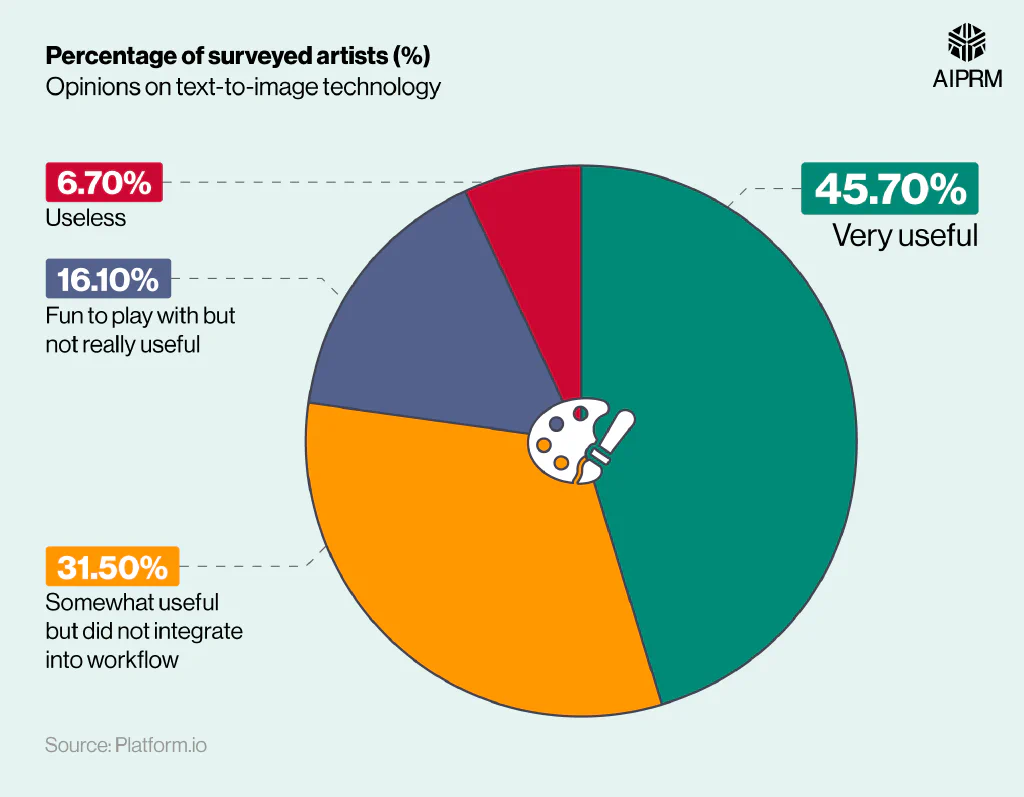
Less than a fifth (16.1%) found text-to-image technology fun to play with while not useful — nearly three times less than the number that found it very useful. Meanwhile, over one in 20 (6.7%) considered the technology useless, around five times less than those who found it somewhat useful.
How are artists using AI? #
Analysis of AI art statistics found that more than one in ten (11.2%) surveyed artists have used text-to-image technology to create something resembling a fully digital work. This is almost three times less than the number of artists who have created image assets for use in other projects.
A breakdown of the usage levels of text-to-image technology among surveyed artists #
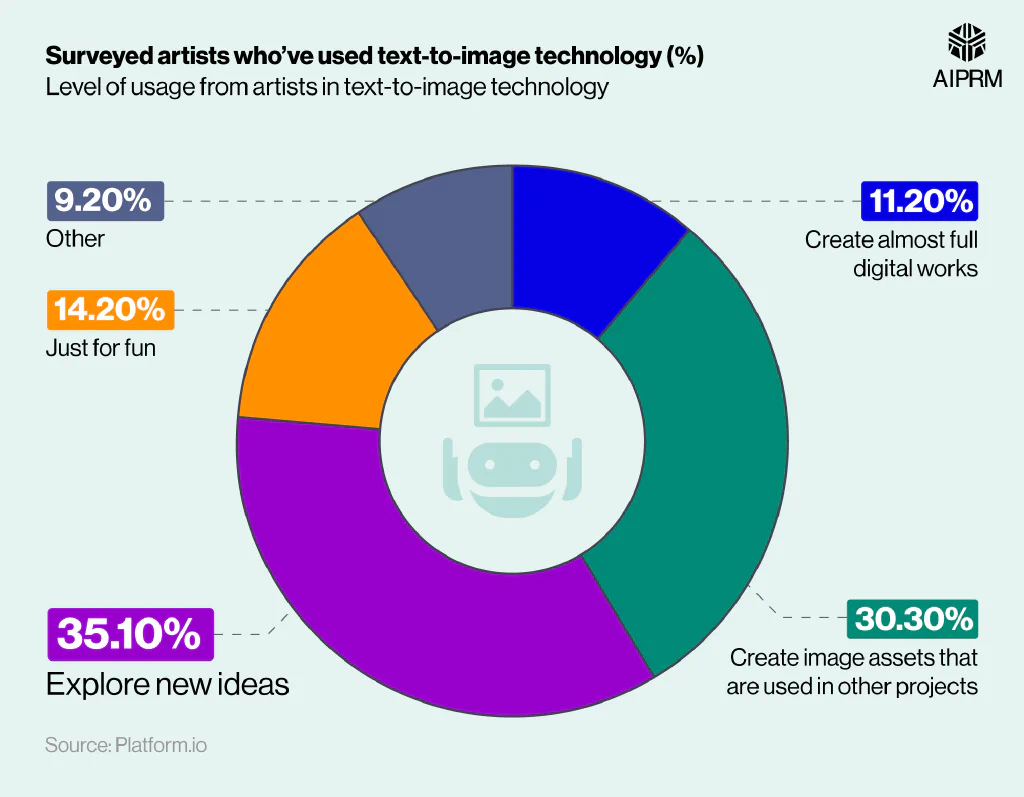
Over a third (35.1%) of artists have used a text-to-image platform to explore and develop new ideas, making this the most common reason overall. Meanwhile, just over 14% said they’d used the technology for fun — less than half the number who’d used it to create image assets for other projects.
A breakdown of the ways surveyed artists plan to showcase their text-to-image creations #
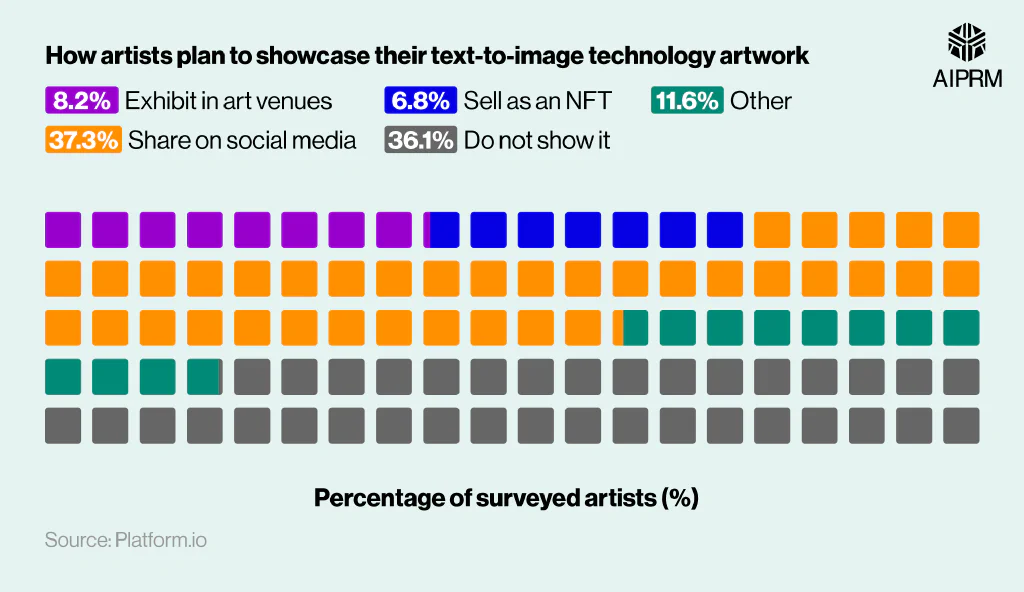
Despite the growing use of AI in art, less than one in ten (8.2%) surveyed artists said they plan to showcase their text-to-image artwork in art venues. Similarly, just over one in twenty (6.8%) claim they plan to sell their AI art creations as NFTs.
More than a third of respondents said they plan to share their text-to-image artwork on social media. This is around four times more than the number planning to exhibit their work in art venues and the most popular answer overall.
Meanwhile, over a third of artists claim they do not plan to showcase their AI art — around five times more than the number planning to sell their work as NFTs.
How much do humans contribute to the creation of AI art? #
More than half (53.6%) of surveyed artists feel that they made a fundamental input to the artwork produced while using text-to-image technology, according to generative AI statistics. This is over 14% more than any other response, bearing testament to the power of effective prompts when producing AI-based art.
A breakdown of the level of personal contribution surveyed artists felt they had when producing text-to-image artwork #

Nearly two-fifths (39%) feel they had very little contribution to the work produced, while less than one in ten (7.4%) feel they had no contribution. According to AI art statistics, over 92% of artists feel they had at least some influence on the artwork produced when using text-to-image technology.
AI art generator tools statistics #
Recent AI art statistics found that Midjourney is the most popular AI generator for creating images. Midjourney is responsible for over a quarter (26.8%) of the global market for generative AI image tools — over 2% more than any other platform.
A breakdown of the global market share of the biggest generative AI image tools in 2024 #

Dall-E holds the next highest market share, accounting for just under a quarter of the global market (24.35%) — 0.83% more than third-placed Nightcafe.
Starry AI and Stable Diffusion round out the top five, with market shares of 12.75% and 12.52%, respectively. This means that, combined, the five biggest generative AI image platforms are responsible for over 99% of the global market.
Which AI tools have created the most images? #
As of 2024, models based on the Stable Diffusion platform have created more than 12.5 billion images. This is over 12 times more than the next highest platform, making Stable Diffusion the only company responsible for more than 10 billion AI images.
A breakdown of the total AI images created by various AI art generators, as of 2024 #
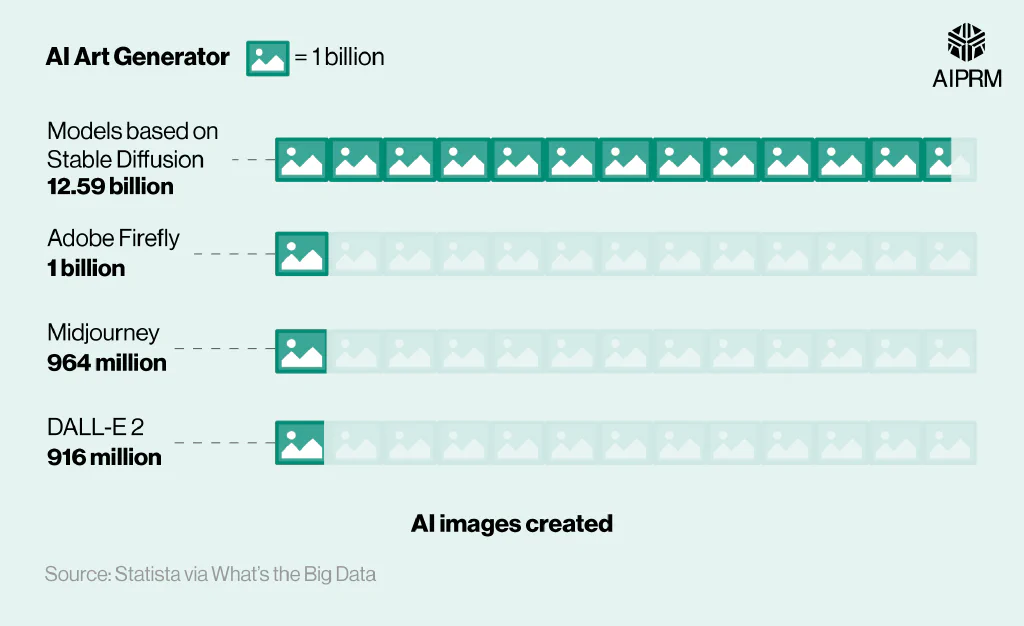
Adobe Firefly was the only other platform to have reached 1 billion AI images as of 2024. This was around 4% more than Midjourney and 9% more than DALL-E 2 — the platforms with the third and fourth highest totals, respectively.
What are the most popular AI tools among artists? #
Recent AI statistics found more than a quarter (28.3%) of artists citing Dall-E 2 as their preferred AI image creation tool in 2023, making it the most popular tool among artists. This was around 1% more than Midjourney (27.1%), making these platforms the only ones chosen by over a fifth of artists.
It’s worth noting that Dall-E 2 has since been updated by Dall-E 3, which was released in August 2023.
A breakdown of the most popular AI art tools among artists #

Over one in ten said Playform is their preferred AI tool for image creation, which is less than half the number for Midjourney and Dall-E 2. Meanwhile, just over one in twenty opted for Starry AI, 7% less than the number who cited Playform.
AI draws from databases that collect digitized works of human creativity. LAION-5B, an online set of nearly 6 billion pictures, has enabled computer models like Stable Diffusion to make derivative images, such as headshot avatars remixed into superheroic or anime styles that went viral on Twitter in 2022.
AI art draws from large databases that store digitized versions of work created by humans. LAION-5B is a large-scale data set that has been used to power leading platforms like Stable Diffusion. The platform draws on a set of nearly 6 billion images to produce a wide range of artwork and imagery.
Attitudes towards AI in art #
A 2023 report from Pew Research found that nearly a third (31%) of people who’d used text-to-image AI software considered it a major advancement for visual arts. Additionally, nearly two-fifths (39%) considered it a minor advancement, meaning seven in ten users believe the software has advanced visual arts to some degree.
A 2023 survey from Book an Artist found that nearly three-quarters (74%) of artists consider the process of AI scraping artwork from the internet to be unethical, with a further 89% worried that copyright laws are outdated.
More than half (54.6%) fear that AI’s impact on artists could result in a decrease in income, with almost three-quarters (73%) saying they want to be asked for permission before their artwork is used to train an algorithm.
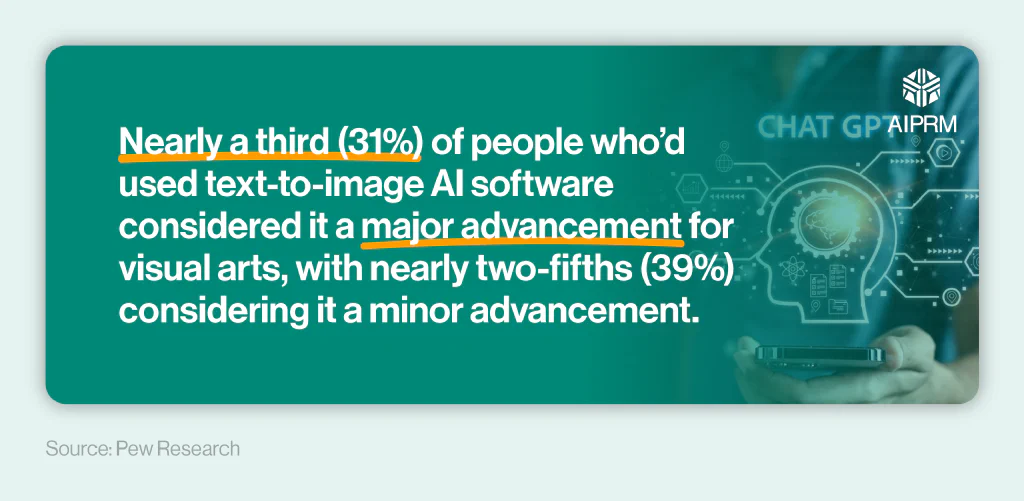
Should artists be compensated when AI copies their work? #
The latest AI art statistics found that seven out of ten (70%) US adults believe that artists should be compensated in instances where generative AI has utilized their work to produce images.
A breakdown of the attitudes of surveyed US adults on the use of generative AI for copying artists’ work in April 2023 #

Over two-fifths (44%) of surveyed adults claimed they’d asked AI to copy an artist’s style, and a similar number (43%) believed that companies should ban the practice.
A breakdown of the attitudes of US adults around artistic credit for AI-based art #
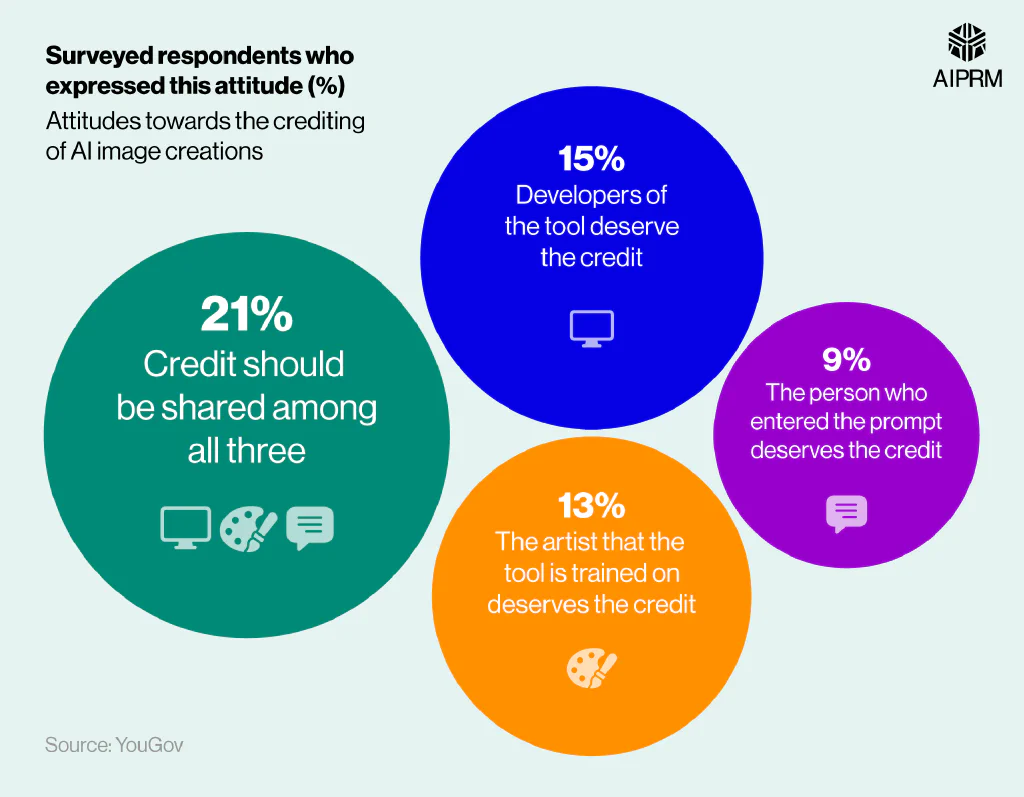
Less than a tenth (9%) of respondents in a YouGov survey believe that the person entering the prompts when creating AI art deserves to be credited. This is 6% lower than the number who believe the developers of the tool should be credited (15%).
Over a tenth (13%) believe that the artist whose work the tool has been trained on deserves to be credited — 4% more than those who believe credit belongs to the prompt writer.
More than a fifth (21%) believe the credit should be shared between the prompt writer, the original artist, and the tool. This is 8% more than the number who believe that credit lies solely with the AI program, making it the most popular position overall.
Can AI in art cause the spread of more fake news/misinformation? #
There is considerable concern around image-based AI’s capacity to spread misinformation, with over half (53%) of respondents in a YouGov survey believing AI image tools are very or somewhat likely to contribute to the spreading of fake news.
A breakdown of the percentage of adults in the US who feel AI image tools will be used to spread fake news #
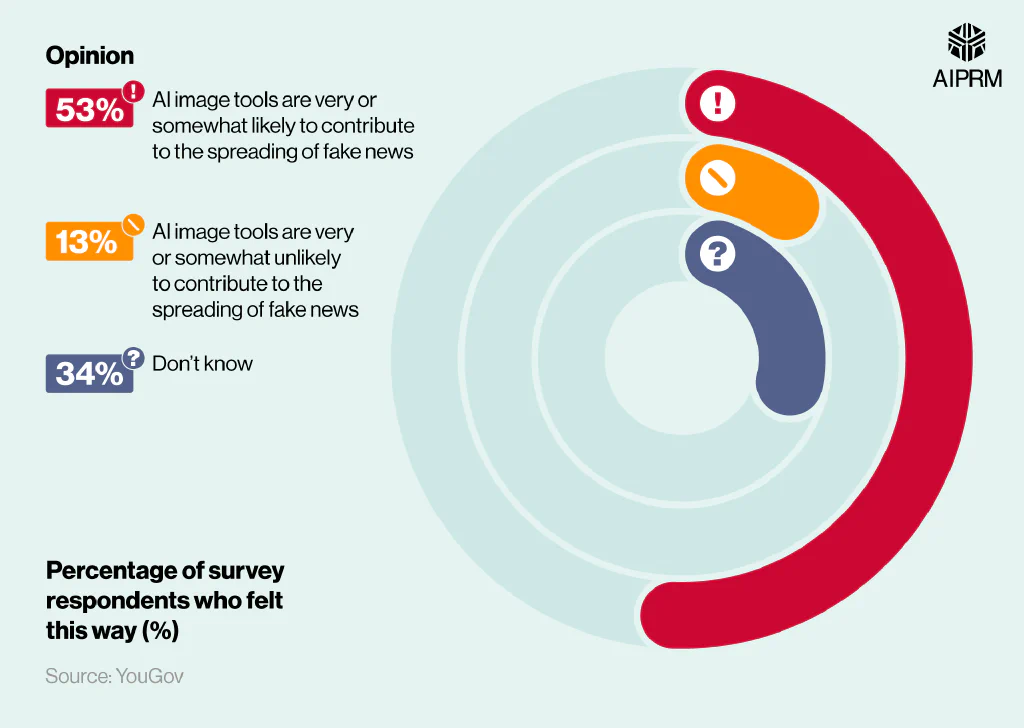
This was 40% more than the number of people who believe AI image tools are very or somewhat unlikely to spread fake news (13%), with over a third (34%) saying they are unsure.
Should AI-generated art be considered art? #
In 2023, an art competition at the Colorado State Fair was won by a piece of digital artwork. Created by Jason M. Allen, the piece, titled Théâtre D’opéra Spatial or Space Opera Theater, was created using Midjourney.
The result sparked a lot of controversy, with many debating whether AI-generated images should be considered art.
Visit our blog for expert advice on a range of topics including an artificial intelligence guide for creatives.
A breakdown of the percentage of survey respondents who believe AI-generated images should be considered art #
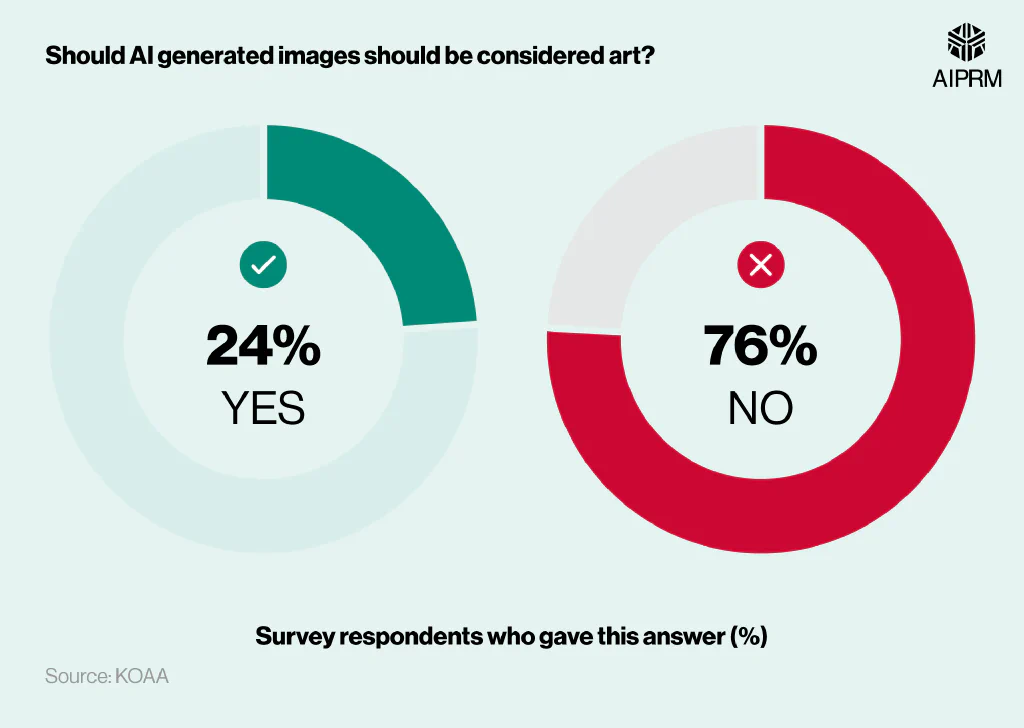
A 2023 survey from news outlet KOAA found that over three-quarters (76%) of people believed AI-generated content like Allen’s piece should not be considered art. This was more than three times more than the number of people who believed that AI generated images should be considered art (24%).
How easy is it to distinguish AI art from human art? #
In a bid to distinguish the difficulty in distinguishing AI art from human art, seven researchers from the University of Chicago conducted a study incorporating 280 human artwork creations and 320 AI-generated images.
They then put each image through six prominent AI detection tools to compare the accuracy levels of each tool.
AI in art value statistics #
As of July 2024, the record for the most expensive piece of AI art ever sold stands at $432,500, according to AI art statistics. The piece, titled Portrait of Edmond de Bellamy, was sold for this fee on the 25th of October 2018 at a Christie’s auction in New York.
Elsewhere, one of the best-selling AI-generated NFT artists is Botto, an AI art tool which uses algorithms to create ideas based on the feedback and ideas of its community members.
After just a month of existence, Botto created and sold four AI-generated NFTs for $1.1 million. By 2024, the program had generated over $4 million in sales in the three years since it was launched.
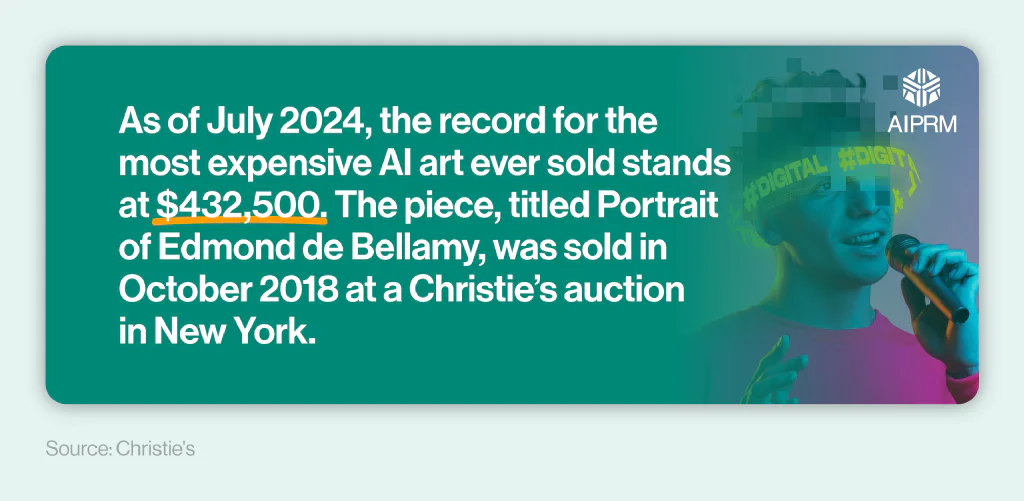
The future of AI in art #
Recent AI art statistics found that nearly half (45.6%) of artists feel text-to-image software will have a dramatic positive influence on creative practices. This was the most common response, with over a third (37.4%) believing the creative process would be somewhat affected.
A breakdown of the levels surveyed artists feel that text-to-image software will affect their creative practice in the future #
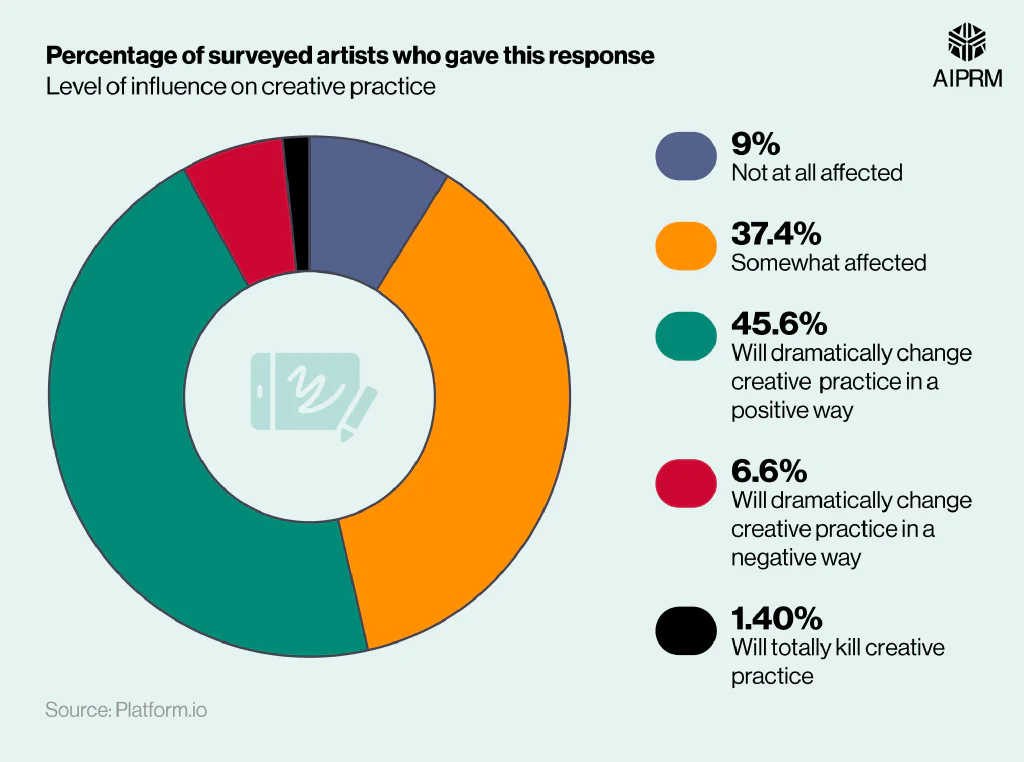
Just over one in twenty (6.6%) believe text-to-image software would dramatically affect creative practice negatively — around 40% less than those predicting a dramatic positive change.
Meanwhile, nearly a tenth (9%) believe the technology will have no effect on creativity, with just one in 100 (1.4%) believing text-to-image software will completely kill creative practices.
AI in art FAQs #
What is the top-rated AI art generator?
Dall-E 2 was the AI art generator cited by most artists as their preferred platform in 2023. Over a quarter (28.3%) of surveyed artists picked Dall-E 2 as their top choice — 1.2% more than second-placed Midjourney. It’s worth noting that Dall-E 2 has since been updated by Dall-E 3, which was released in August 2023.
What percentage of people like AI art?
A survey from YouGov found that 56% of respondents who’d seen AI art claimed they liked it, compared to just 19% who didn’t.
Where does AI art get data from?
Text-to-image generative AI platforms are built on large databases made up of numerous image and text-based sources. By training on these vast sets of data, the programs are then able to accurately decipher the type of imagery a human is requesting based on their prompts.
When did AI art become popular?
While the concept of AI and art has been experimented with for decades, the generative AI boom towards the end of 2022 dramatically increased knowledge and interest in AI art. Since then, many artists have experimented with technology as a tool to enhance their existing artistic process, while numerous non-artists have used these programs as image creation tools, both for work activities and leisure.
Will AI take over art?
Although it seems unlikely that AI will replace the traditional artistic process in the future, it will likely play a key role in the development and evolution of art in the coming decades.
By working on human prompts, AI has the power to enhance the ideation process for artists, bringing to life ideas that can then be developed further by the artists using their traditional methods.
Also, the growing interest in AI-based art shows no sign of waning, meaning it’s likely that the AI art market will continue to generate its own interest separately from the traditional art industry.
Why is AI-generated art bad?
Critics of AI-generated art believe that it lacks the emotion, originality, and intent associated with the best human art. As the technology relies on interpreting data from existing work, many critics feel that it lacks the ability to innovate in the way that traditional art can.
Will AI art replace artists?
While AI may replace certain image creation tasks performed by artists in workplaces, it’s unlikely that they will replace human artists completely. Because image-based AI relies on interpreting existing work created by humans to produce its own art, it cannot create truly independent artwork in the same way that a human can.
How to use prompts in AI art?
Prompts work in AI art by taking a descriptive written theme from a human and interpreting it into an image. Therefore, making your prompts as specific and descriptive as possible will increase the likelihood of the AI program accurately interpreting your idea.
Glossary #
Chat-GPT #
Chat-GPT is a chatbot and virtual assistant released by Open AI in November 2022. The program is trained on large language models to answer questions and perform text-based tasks based on human prompts.
Generative AI #
Generative AI is a type of artificial intelligence used to create content like text, images, audio, and video. Generative AI programs interpret requests by humans known as prompts, to produce content based on large data sets.
Prompt #
A prompt is a text-written human command given to an AI program, that the program will use to create a piece of text or imagery.
Text-to-image software #
Text-to-image software is a type of generative AI program in which images and artwork are created by an AI based on its interpretation of human prompts.
Sources #
https://www.fortunebusinessinsights.com/ai-image-generator-market-108604
https://www.katevassgalerie.com/blog/harold-cohen-aaron-computer-art
https://en.wikipedia.org/wiki/AARON
https://www.playform.io/editorial/survey
https://www.gartner.com/en/articles/beyond-chatgpt-the-future-of-generative-ai-for-enterprises https://www.statista.com/forecasts/1423989/world-generative-ai-image-tool-market-share
https://www.similarweb.com/website/midjourney.com/
https://whatsthebigdata.com/ai-art-generator-statistics/
https://www.popsci.com/technology/artificial-intelligence-art-statistics/
https://bookanartist.co/blog/2023-artists-survey-on-ai-technology/
https://www.statista.com/statistics/1400650/perception-of-copying-artists-work-using-ai-us/
https://business.yougov.com/content/45765-half-americans-think-ai-art-will-be-used-spread-fa
https://yaledailynews.com/blog/2023/01/23/what-ai-art-means-for-society-according-to-yale-experts/
https://www.koaa.com/news/news5-originals/koaa-survey-should-ai-generated-images-be-considered-art
https://beincrypto.com/ai-artist-made-3-million-selling-nfts/